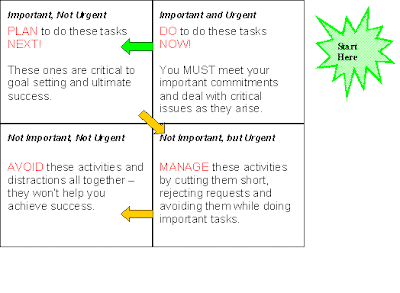Note that it is commonly recognized that 20% of your activities will account for 80 percent of your success (The Pareto Principle). Hence, if you have 100 tasks in your task list, probably about 20 of those will be the key ones to focus on. Hence, whatever prioritization method you use, you should ensure it helps you pinpoint these tasks.
Stephen R. Covey the author of The 7 Habits of Highly Effective People described a high-level prioritization scheme by assigning a level of ‘urgency’ and ‘importance’ to all tasks.

It is human nature to instinctively act on tasks that are ‘urgent’, whether these are tasks are important or not. Dr. Covey notes that highly effective people make time for the QII activities and that doing so can reduce the time spent in other quadrants.
After you identify what quadrant your tasks belong in you can prioritize your tasks by working from QII to QI to QIV to QIII like this:

Based on Covey’s Urgent/Important Priority Matrix there is a simple priority planning model that everyone can use for success:
IMPORTANCE (I) * URGENCY (U) = SUCCESS (S)
Follow these five steps to prioritize your tasks for Success:
1) List your tasks or activities.
2) Identify the IMPORTANCE (I) for each task, with 1 being the most important.
3) Assign a numerical value for the URGENCY (U) of each task (1=Urgent, most time-sensitive; 2=Important, needs to be done; 3=Important, but can wait).
4) Multiple IMPORTANCE time URGENCY to determine the SUCCESS (S) factors for each task.
5) Rank each task from highest to lowest by SUCCESS factor.
What techniques/tools do you use to prioritize your day-to-day task and goal orientated activities?


"Urgent" is always pegged to time limits and cannot always be relegated to second choice when the deadline is official. Then it is a "must do" through and through. This is basically the cause of what you graphically point out in your chart. What is important for the individual may not be the priority for the group or the company. What priority prevails then?
ReplyDelete